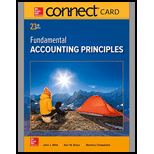
Cost behavior analysis : Cost behavior analysis means to study how the cost changes as the level of volume changes. Sometimes it may be fixed, it may be variable, it may be constant at certain level etc.
To Match
In the given question we have to match cost classifications in left side column with the definitions given in right side column.
Given Info:
Left side column:
- Total cost
- Mixed cost
- Variable cost
- Curvilinear cost
- Step-wise cost
- Fixed cost
Right side column:
1. This cost is the combined amount of all the other costs.
2. This cost remains constant over a limited range of volume; When it reaches the end of its limited range, it changes by a lump sum and remains at that level until it exceeds another limited range.
3. This cost has a component that remains the same overall volume levels and another component that increases in direct proportion to increases in volume.
4. This cost increases when volume increases, but the increase is not constant for each unit produced.
5. This cost remains constant overall volume levels within the productive capacity for the planning period.
6. This cost increases in direct proportion to increases in volume; its amount is constant for each unit produced.
Match:
| Left Column | Right Column |
| A | 1 |
| B | 3 |
| C | 6 |
| D | 4 |
| E | 2 |
| F | 5 |
Want to see the full answer?
Check out a sample textbook solution
Chapter 21 Solutions
Connect Access Card for Fundamental Accounting Principles
- Carrington Trading is a merchandising company. Last month, the company's cost of goods sold was $72,800. The company's beginning merchandise inventory was $24,500, and its ending merchandise inventory was $21,300. What was the total amount of the company's merchandise purchases for the month?arrow_forwardPlease provide the answer to this general accounting question using the right approach.arrow_forwardDescribe how inventory is valued under FIFO and LIFO methods.arrow_forward
- Die Industries began operations on March 1 with cash of $150,000. All of March's $240,000 sales were on account. During March, no customer collections occurred. The cost of goods sold was $95,000, and there were no ending inventories or accounts payable. Use this information to determine the ending balance of cash on hand for March.arrow_forwardWhat is Redmont enterprise total equity ?arrow_forwardI am searching for the most suitable approach to this financial accounting problem with valid standards.arrow_forward

 AccountingAccountingISBN:9781337272094Author:WARREN, Carl S., Reeve, James M., Duchac, Jonathan E.Publisher:Cengage Learning,
AccountingAccountingISBN:9781337272094Author:WARREN, Carl S., Reeve, James M., Duchac, Jonathan E.Publisher:Cengage Learning, Accounting Information SystemsAccountingISBN:9781337619202Author:Hall, James A.Publisher:Cengage Learning,
Accounting Information SystemsAccountingISBN:9781337619202Author:Hall, James A.Publisher:Cengage Learning, Horngren's Cost Accounting: A Managerial Emphasis...AccountingISBN:9780134475585Author:Srikant M. Datar, Madhav V. RajanPublisher:PEARSON
Horngren's Cost Accounting: A Managerial Emphasis...AccountingISBN:9780134475585Author:Srikant M. Datar, Madhav V. RajanPublisher:PEARSON Intermediate AccountingAccountingISBN:9781259722660Author:J. David Spiceland, Mark W. Nelson, Wayne M ThomasPublisher:McGraw-Hill Education
Intermediate AccountingAccountingISBN:9781259722660Author:J. David Spiceland, Mark W. Nelson, Wayne M ThomasPublisher:McGraw-Hill Education Financial and Managerial AccountingAccountingISBN:9781259726705Author:John J Wild, Ken W. Shaw, Barbara Chiappetta Fundamental Accounting PrinciplesPublisher:McGraw-Hill Education
Financial and Managerial AccountingAccountingISBN:9781259726705Author:John J Wild, Ken W. Shaw, Barbara Chiappetta Fundamental Accounting PrinciplesPublisher:McGraw-Hill Education





